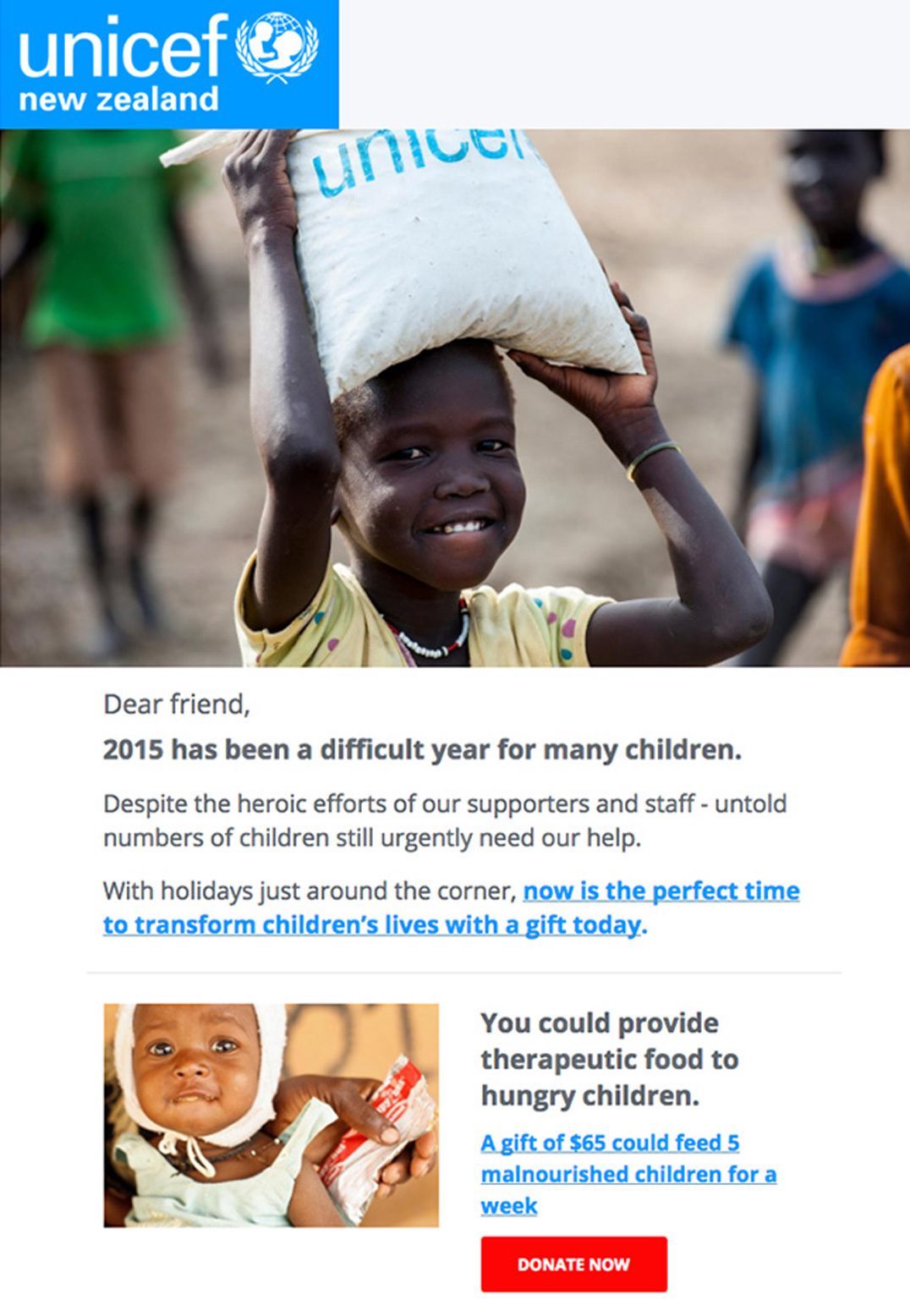Article first published April 2018, updated September 2019
Nonprofit organizations support good causes, work with the resources they have, and tirelessly try to make the world a better place. But it isn’t easy.Nonprofits rely on the generosity of donors and supporters to make a difference. With the nonprofit landscape constantly changing, capturing the attention of these busy people is challenging.
Today’s nonprofit marketers and donor relations managers wonder how they can cultivate meaningful relationships, as well as take advantage of available technology to engage donors and learn more about their preferences and behaviors.
Last month, Campaign Monitor partnered with CauseVox to host the San Francisco stop of CauseVox Live. At the event, we dug into the questions plaguing nonprofits today. CauseVox Live included an insightful, inspiring panel discussion featuring experts ranging from CauseVox’s CEO, Rob Wu, to top fundraisers from San Francisco’s Amigos and BAYCAT.
Experts shared key facts, insights, and nonprofit best practices to help attendees stay up to date on how to effectively connect with current donors and gain new ones. Here are three helpful takeaways we learned straight from the pros at CauseVox Live.
1. Donor and fundraising behaviors have shifted.
Relationship-based fundraising is here to stay. As donor behavior shifts, technology is simultaneously shifting to keep up. These technological shifts allow nonprofits to pave new paths to connect with their donors, volunteers, and supporters.
Rob Wu shared that he finds the new era of fundraising to be community driven. Instead of focusing on email blasts, which were prevalent (and ineffective) in the past, today’s nonprofits are focused on relationship-based fundraising efforts, with the goal to connect with donors in a personal way.
Here are some ways that donor behavior has shifted:
Donors want to have a personal connection to the causes they support.
They want to see the effects of their donations or participation. Be transparent with the impact your organization is having. This builds authentic donor relationships and support.
Three of the best ways to do this are:
Use images in your email communication.
Images are a powerful medium for building emotional connections. When people see what you’re doing with their donations, they feel proud of their input. More than that, they feel like an important part of the team, and they are. So, as much as possible, use images of your staff on the ground or images of the people or cause you’re supporting in your emails.
Source: Campaign Monitor
Employ storytelling.
Storytelling is another great way of connecting your donors to the cause they’re supporting. Tell the stories of the recipients of the donations and make sure to include the donor in it. A simple way to do that is to include the word “you” in the story. Here’s a classic example from UNICEF New Zealand:
Source: Campaign Monitor
Send a Thank You note.
Thank you. Those are two of the most impactful words you can say to anyone. Not only does saying thank you make your donors feel appreciated, but it also helps them know that their contribution is needed. It builds a sense of ownership of the cause, and this will also lead them to faithfully support your cause.
Try as much as possible to make your donors feel connected to the cause they’re supporting. Doing so ensures that they become recurring donors.
Donors want updates after they make donations.
Update your donors and keep them in the loop to show them that they’re a part of your cause. Nothing breeds distrust as much as keeping information from your donors. A very good way of keeping your donors updated is by creating and sending out a regular newsletter. When designing your newsletter, remember to:
- Make it informational yet engaging.
- Include a link to your website for readers to learn more.
- Include social media sharing buttons for your donors to help you spread the word.
Source: Really Good Emails
If you haven’t started sending out a newsletter yet, you’re missing out on a big opportunity to increase brand awareness and spread the word about your cause. However, it’s not too late to start one. That’s where an email service provider like Campaign Monitor can help. Thanks to its easy-to-use email automation feature and nonprofit-specific templates, you’ll have your first newsletter ready in no time.
Technology has changed the way we interact.
With endless amounts of information in our pockets, there are strong social changes in how we communicate and participate. Nonprofits that adapt to the changing landscape will likely be the ones who thrive.
Noah Barnett with CauseVox said it best: “Your donors are humans, not just a number on a spreadsheet or a dollar sign in your bank account.” Turning a transactional relationship into a person-to-person relationship will do wonders for your fundraising strategies.
2. An engaging campaign excites supporters.
Prospective and current donors want to connect and get excited about the work your organization is doing. A powerful way to provide a personal connection and show impact is to give supporters the floor and let them tell your story.
Taylor Martin, Amigos’ Regional Outreach Manager, shared how Amigos teamed up with alumni of the program to create buzz around both the alumni’s causes and their own.
For example, Dorn Wenniger, a six-summer volunteer of the Amigos program, decided to take on a giant goal and in tangent raise awareness for Amigos. He raised donations to run seven marathons in seven days on seven continents. All funds he raised were given to Amigos.

Taylor expressed the power of Dorn personally expressing Amigos’ story, how the organization has impacted him, and what he’s doing in support of their message.
The lesson? It’s powerful to tell your own story as a nonprofit, but it’s even more powerful to hear your mission through supporters.
BAYCAT’s development director shared the same effect after a campaign they ran, sharing: “Hearing our story told through our supporters is inspiring … it also helped us raise more online and further fund our programs.”
It’s key to maintain donor relationships and find out what fuels their stewardship. Why were they excited to donate last year? Give your donors the platform to share their experience with your audience.
3. Learning about donors and segmenting your campaigns brings results.
Today’s technology allows us to engage individual donors and learn how they want to communicate. How can you talk to donors with differing interests, and how do you choose the correct cadence and messaging?
Campaign Monitor’s Senior Customer Success Manager, Allison Wahl offered a key solution based on what she’s learned from working with customers like Unicef, Burning Man, and more. By leveraging today’s technology and taking a behaviorally driven approach, you can immensely improve the accuracy of your messaging.
A donor or potential donor who’s visited your site once should be spoken to in a different way than somebody who’s visited 50 times. Through tapping into behavioral tools, you can connect with them in a unique, personal way.
Confident organizations encourage risks and defensive organizations are risk averse.
Using segmentation allows your organization to take risks by testing exactly which content and messaging specific groups of your audience want to receive. Segmentation tactics can be based on:
- Location
- Demographics
- Past activity
- Market
- Workflow activity
- Donor/volunteer persona
For example, Red Cross segments their audience from the very beginning. They let their subscribers choose how much personalization they prefer based on the information they include in their signup form:

Segmentation allows you to discover exactly what your specific donors/potential donors need from you to stay engaged and happy with your organization.
How nonprofits can run integrated campaigns
For your nonprofit marketing plan to have maximum impact, you must consider integrating other communication channels into your strategy. Technological advancements have made it easier for you to reach a wider audience through digital channels. For example:
- Content marketing. Create content in the form of blog posts or videos and publish them on your own website or other publications.
- Social media. Social media is a powerful marketing channel that you can use to promote your cause and other digital assets.
- Chatbots. Chatbot technology is another great way of communicating with visitors to your website. Use it to share valuable information and direct visitors on what they need to do to make an online donation.
Next time you run a nonprofit marketing campaign, go all out and integrate every channel possible into your marketing strategy.
Wrap up
The nonprofit space is constantly changing, and how you adapt to change is key to success. Never stop learning from your audience, testing to discover what they need, and using segmentation tools to ensure you’re reaching out to donors as humans, not just an inbox.
The dynamic shifts and trends in donor behavior can be a lot to keep up with. The insights presented by the experts at CauseVox Live gave each attendee fresh ideas on how they can utilize current engagement and fundraising channels. We also left with a full appreciation for all of the hard, meaningful work done by today’s nonprofit organizations.
For more in-depth nonprofit marketing insights, tips, and strategies, be sure to check out our nonprofit marketing guide to help you master the art and science of fundraising for your cause.








